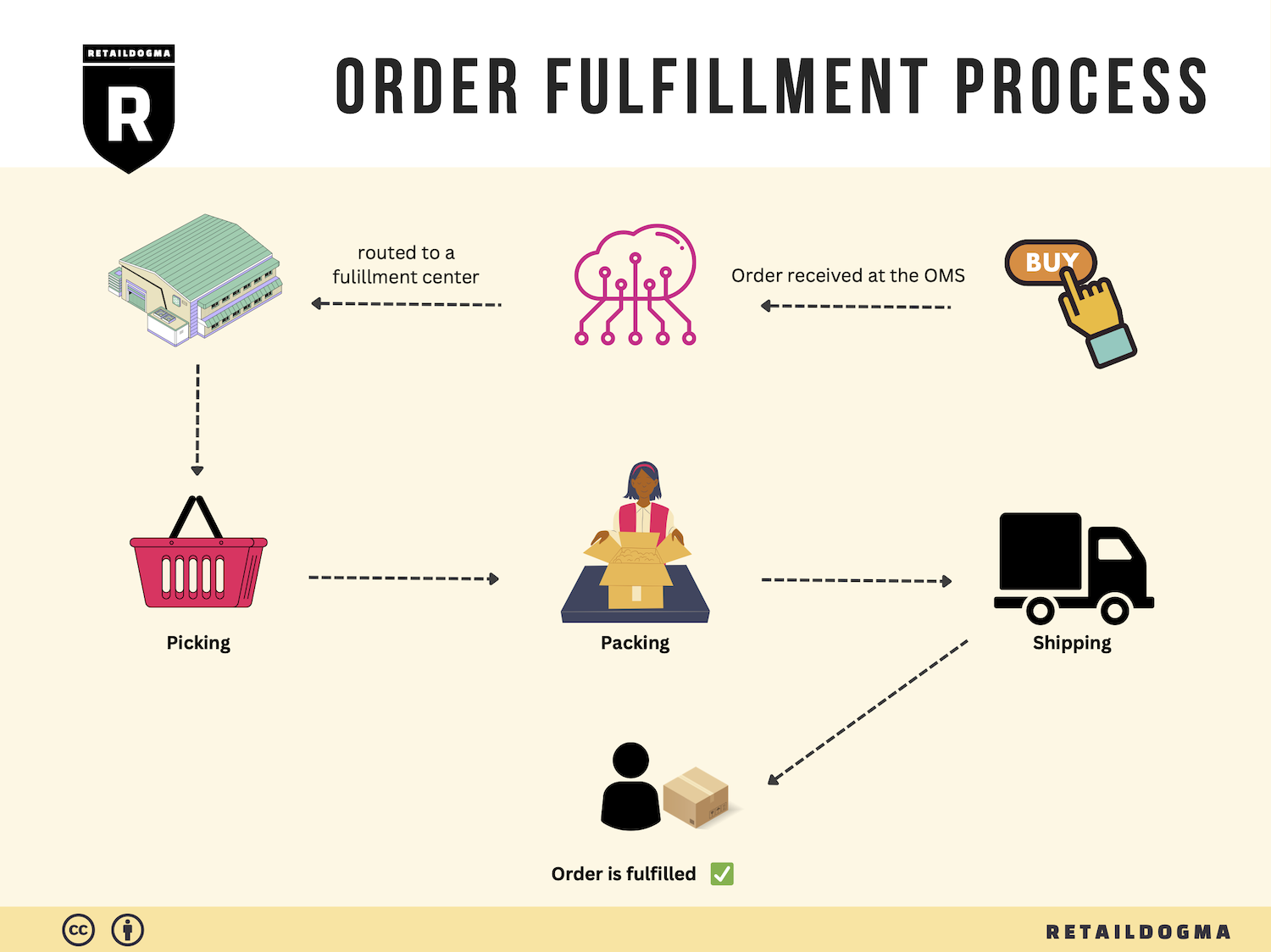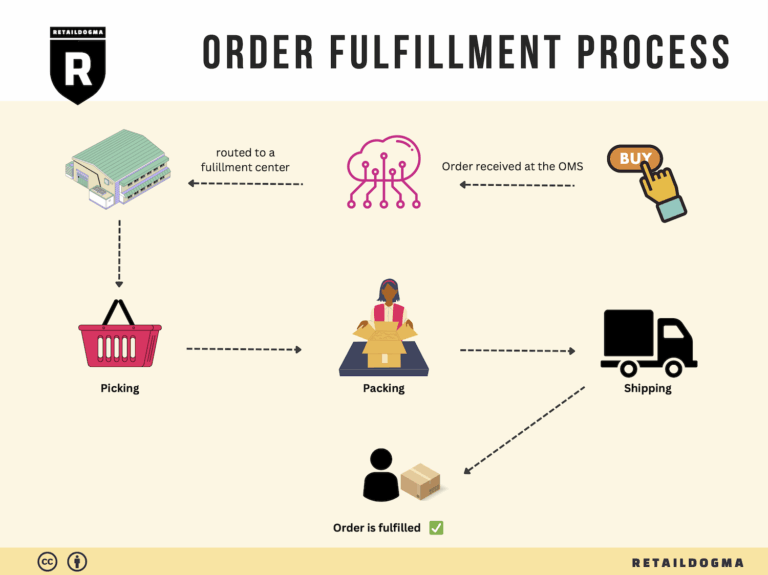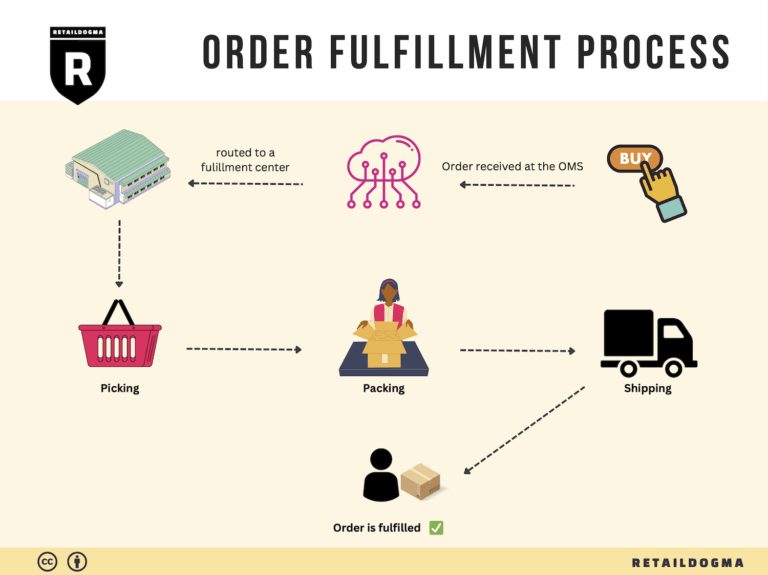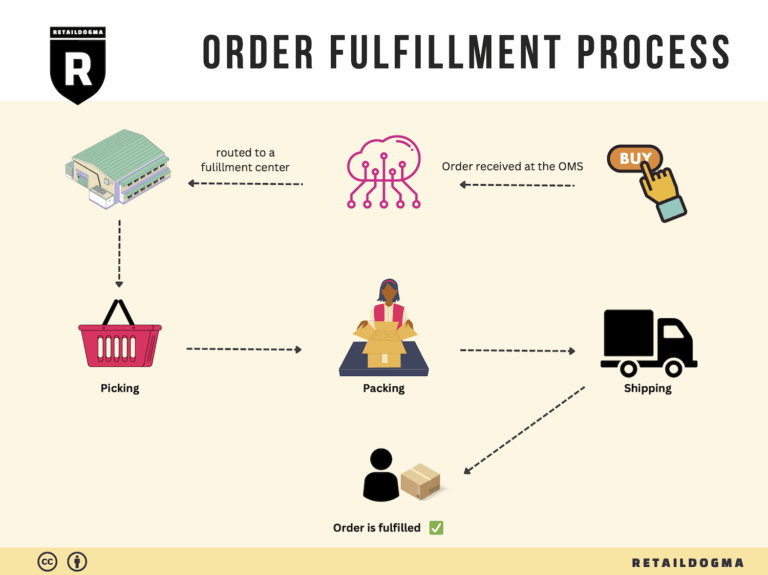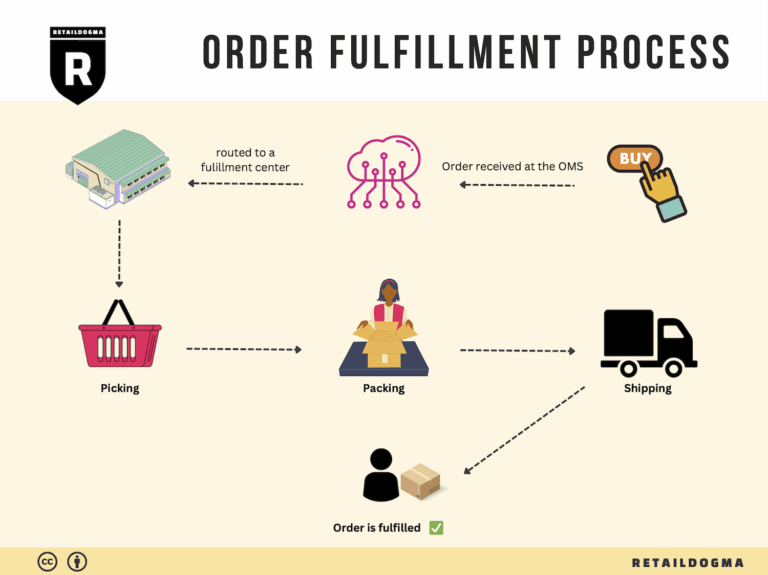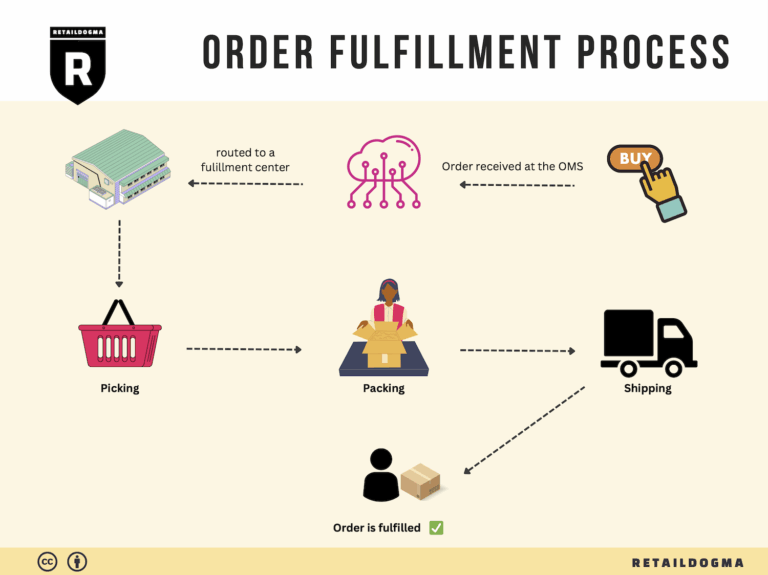Ecommerce Fulfillment Services: The Ultimate Guide (2025)
What is E-commerce Fulfillment? An Introduction for Growing Businesses
Understanding E-commerce Fulfillment: A Key to Scaling Your Business
As an e-commerce business owner, you may find yourself grappling with a common challenge: the overwhelming task of packing and shipping orders. The excitement of growing sales can quickly turn into stress when faced with logistics complexities. This is where effective e-commerce fulfillment becomes essential. At its core, fulfillment is simply the process of getting a product from your warehouse to your customer’s doorstep. However, mastering this process is crucial for maintaining customer satisfaction and ensuring sustainable growth.
In this guide, we will delve into the various models of e-commerce fulfillment, including Third-Party Logistics (3PL) and Fulfillment by Amazon (FBA). Understanding these options will help you determine which model aligns best with your business goals and operational needs. Each fulfillment model comes with its own set of advantages and challenges, and we will break down these aspects to provide clarity.
We will also explore the core services involved in e-commerce fulfillment. From inventory management and order processing to packing and shipping, each step plays a vital role in ensuring that orders are delivered accurately and on time. Effective inventory management not only reduces costs but also enhances customer experience by minimizing stockouts and delays.
Choosing the right fulfillment partner is a critical decision that can significantly impact your business’s efficiency and customer satisfaction. This guide will outline essential criteria to consider when evaluating potential partners, including their capabilities, technology, and service levels. Additionally, we will discuss pricing structures associated with different fulfillment services, enabling you to make informed financial decisions that support your growth.
Ultimately, our goal with this guide is to empower you to make smart decisions about your logistics operations. By understanding the nuances of e-commerce fulfillment, you can streamline your processes, enhance customer satisfaction, and position your business for scalable success. Whether you’re just starting out or looking to optimize your existing operations, this comprehensive guide will serve as a valuable resource in navigating the complexities of e-commerce fulfillment.

What You’ll Learn In This Guide
- What is E-commerce Fulfillment? An Introduction for Growing Businesses
- The Order Fulfillment Process: From ‘Buy’ Button to Customer’s Door
- Comparing Fulfillment Models: In-House vs. 3PL vs. Dropshipping
- A Deep Dive into Amazon FBA: Pros, Cons, and Who It’s For
- Core Services Offered by Fulfillment Centers
- How to Choose a Fulfillment Partner: A 6-Point Checklist
- Understanding Fulfillment Pricing: A Breakdown of Common Fees
- Frequently Asked Questions (FAQs) about Fulfillment
- Conclusion: Is Outsourcing Fulfillment the Right Move for Your Business?
- Important Disclaimer
The Order Fulfillment Process: From ‘Buy’ Button to Customer’s Door
1. Receiving Inventory
The first step in the order fulfillment process is receiving inventory. This occurs when products arrive at the fulfillment center from various suppliers or manufacturers. Efficient receiving is crucial as it sets the foundation for the entire logistics operation. Upon arrival, items are checked against purchase orders to ensure accuracy in quantity and quality.
During this phase, key terms such as SKU (Stock Keeping Unit) come into play. Each product is assigned a unique SKU, which helps track inventory levels and facilitate future order processing. Proper handling during receiving helps to minimize errors and avoid discrepancies that could lead to stockouts or overstock situations. The use of barcode scanning technology is common, allowing for real-time updates to inventory management systems and ensuring a seamless transition into the next step of the process.
2. Warehouse Storage
Once inventory has been received and verified, the next step is warehouse storage. This process involves stowing items in designated locations within the fulfillment center. Proper storage is essential for maintaining inventory organization and ensuring efficient retrieval later in the order fulfillment process.
In this phase, it’s vital to understand concepts like location optimization. Items are often stored based on their turnover rates; fast-moving products might be placed closer to packing stations for quicker access, while slower-moving items may be stored farther away. Advanced inventory management systems track the exact locations of items through their SKUs, allowing warehouse staff to easily locate products when orders are received. Efficient storage practices not only streamline the picking process but also reduce the time and labor costs associated with searching for products.
3. Order Picking
The third step is order picking, where items are selected from storage in response to customer orders. This step is critical as it directly impacts order accuracy and fulfillment speed. When a customer clicks the ‘Buy’ button, the fulfillment center generates a pick list that details which items need to be retrieved and their corresponding locations.
Various picking methods can be employed, such as single-order picking, batch picking, or wave picking, depending on the volume of orders and the layout of the fulfillment center. Automation has become increasingly prevalent, with robots and automated systems often assisting pickers in retrieving items efficiently. The accuracy of this step is paramount; errors in picking can lead to customer dissatisfaction and increased return rates. By employing technology and best practices in order picking, businesses can enhance their operational efficiency and improve customer service.
4. Order Packing
After items have been picked, they move to the order packing stage. This step is where products are prepared for shipment, making it a critical juncture in the fulfillment process. During packing, items are carefully checked for accuracy against the original order, and appropriate packing materials are selected to ensure safe transit.
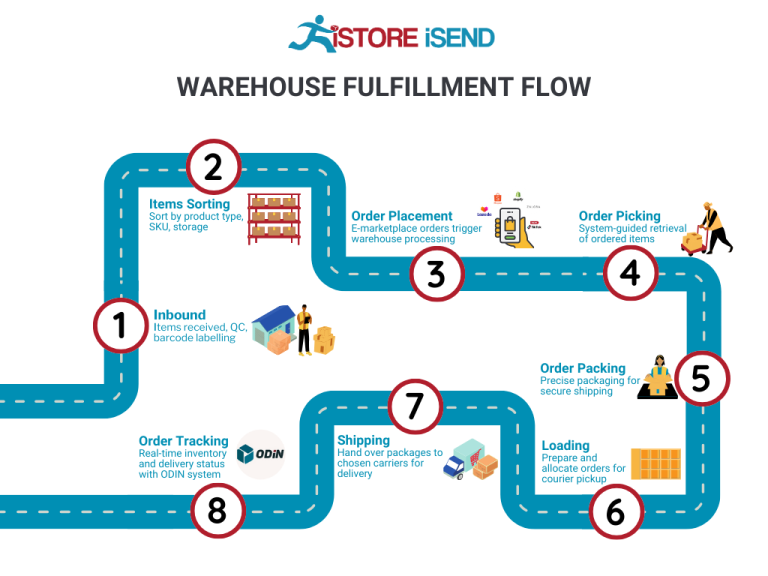
Key terms in this phase include packaging optimization. This involves selecting the right box size and packing materials to minimize waste and protect the items during shipment. Amazon, for example, utilizes sophisticated algorithms to determine the optimal packaging for each order, reducing material costs and environmental impact. This step is crucial for maintaining product integrity and minimizing shipping costs, which are essential for maintaining profitability in e-commerce operations.
5. Shipping & Delivery
The final step in the order fulfillment process is shipping and delivery. Once orders are packed, they are labeled and sorted based on their destination and shipping method. This phase is vital for ensuring that customers receive their orders in a timely manner, which is a key driver of customer satisfaction and loyalty.
During this stage, the term last-mile delivery becomes significant. This refers to the final leg of the shipping process, where packages are transported from the fulfillment center to the customer’s doorstep. Efficient last-mile delivery strategies, such as using local distribution centers or partnering with logistics providers, can greatly enhance delivery speed and reduce costs. Companies like Amazon leverage advanced logistics networks, including their own delivery vehicles and partnerships with carriers, to ensure rapid delivery, especially for Prime members who expect expedited service.
In conclusion, understanding and optimizing each step of the order fulfillment process—from receiving inventory to shipping and delivery—is essential for e-commerce businesses looking to scale effectively. By implementing best practices in these areas, companies can enhance operational efficiency, reduce costs, and ultimately deliver a superior customer experience.
Comparing Fulfillment Models: In-House vs. 3PL vs. Dropshipping
Fulfillment Model Comparison
| Model | Who Handles Inventory | Best For (Business Stage) | Key Advantage | Key Disadvantage |
|---|---|---|---|---|
| In-House Fulfillment | The business itself | Established businesses with stable demand | Full control over inventory and processes | Higher overhead costs and complexity |
| Third-Party Logistics (3PL) | A third-party provider | Growing businesses seeking scalability | Access to expertise and technology | Less control over operations and inventory |
| Dropshipping | Supplier/manufacturer | Startups and low-capital businesses | Low upfront investment and risk | Lower profit margins and reliance on suppliers |
In-House Fulfillment
In-house fulfillment involves managing the entire logistics process internally. This model is typically adopted by established businesses that have a stable demand and can afford the associated overhead costs. Companies that choose in-house fulfillment handle everything from inventory management to order processing, packing, and shipping. The primary advantage of this model is the level of control it provides. Businesses can oversee the entire process, ensuring that quality standards are met and that inventory is managed according to their specific needs. This control can lead to improved customer service, as businesses can respond quickly to issues and changes in demand. However, the disadvantages include high overhead costs associated with warehousing, staffing, and technology investments, as well as the complexity of managing logistics operations. As a business grows, maintaining efficient in-house fulfillment can become increasingly challenging, requiring significant resources and expertise.
Third-Party Logistics (3PL)
Third-party logistics (3PL) refers to outsourcing fulfillment processes to specialized providers. This model is ideal for growing businesses that seek to scale quickly without the burden of managing logistics internally. 3PL providers offer a range of services, including inventory management, order processing, packing, and shipping, often leveraging advanced technology and expertise that may be cost-prohibitive for individual businesses to develop. The key advantage of using a 3PL is the ability to focus on core business activities, such as marketing and sales, while leaving logistics to the experts. This can lead to improved operational efficiency and the ability to scale operations quickly in response to market demands. However, the trade-off is reduced control over inventory and fulfillment processes. Businesses must rely on their 3PL partners to maintain quality and efficiency, which can lead to challenges if the provider does not meet expectations. Additionally, integrating systems and processes between the business and the 3PL can be complex and time-consuming.
Dropshipping
Dropshipping is a fulfillment model where the retailer does not keep goods in stock but instead transfers customer orders directly to a supplier, who then ships the products to the customer. This model is particularly appealing for startups and businesses with limited capital, as it requires minimal upfront investment and eliminates the need for warehousing or inventory management. The primary advantage of dropshipping is the low financial risk involved, as businesses only purchase products after they have been sold. This model allows entrepreneurs to test new products and markets without significant financial commitment. However, dropshipping also presents challenges, including lower profit margins due to reliance on suppliers and potential quality control issues. Since the retailer does not handle the products directly, they have limited control over shipping times and product quality, which can impact customer satisfaction. Additionally, businesses must be diligent in choosing reliable suppliers, as any failure on their part can reflect poorly on the retailer’s brand.
Conclusion
When selecting a fulfillment model, e-commerce business owners and operations managers should consider their current business stage, financial resources, and the level of control they desire over their logistics processes. Each model has its advantages and disadvantages, and the choice will significantly impact operational efficiency, customer satisfaction, and overall business growth. By understanding these differences, businesses can make informed decisions that align with their strategic goals.
A Deep Dive into Amazon FBA: Pros, Cons, and Who It’s For
What is Fulfillment by Amazon (FBA)?
Fulfillment by Amazon (FBA) is a service offered by Amazon that allows sellers to store their products in Amazon’s fulfillment centers. This service manages the logistics of storage, packing, shipping, and customer service, enabling sellers to focus on growing their business. When a customer makes a purchase, Amazon handles the entire fulfillment process, from picking and packing the items to shipping them directly to the customer.
When sellers enroll in FBA, they send their inventory to Amazon’s warehouses, where it is stored until sold. Once an order is placed, Amazon takes over, picking the product from the warehouse, packaging it, and shipping it out. Additionally, FBA products are eligible for Amazon Prime, which provides sellers with an edge in the competitive marketplace.
How FBA Works
-
Inventory Storage: Sellers send their products to Amazon’s fulfillment centers. Amazon stores these products until they are sold.
-
Order Processing: When a customer places an order for an FBA product, Amazon automatically processes the order using its sophisticated inventory management systems.
-
Picking and Packing: Amazon employs a combination of technology and human labor to pick the correct items from inventory and pack them securely for shipment. This includes using robots to transport inventory within the fulfillment center.
-
Shipping: Once packed, Amazon ships the order directly to the customer, utilizing its extensive logistics network. This could include delivery via Amazon Prime, which guarantees fast shipping options.
-
Customer Service: Amazon also handles customer service inquiries related to FBA orders, including returns and refunds, freeing sellers from these responsibilities.
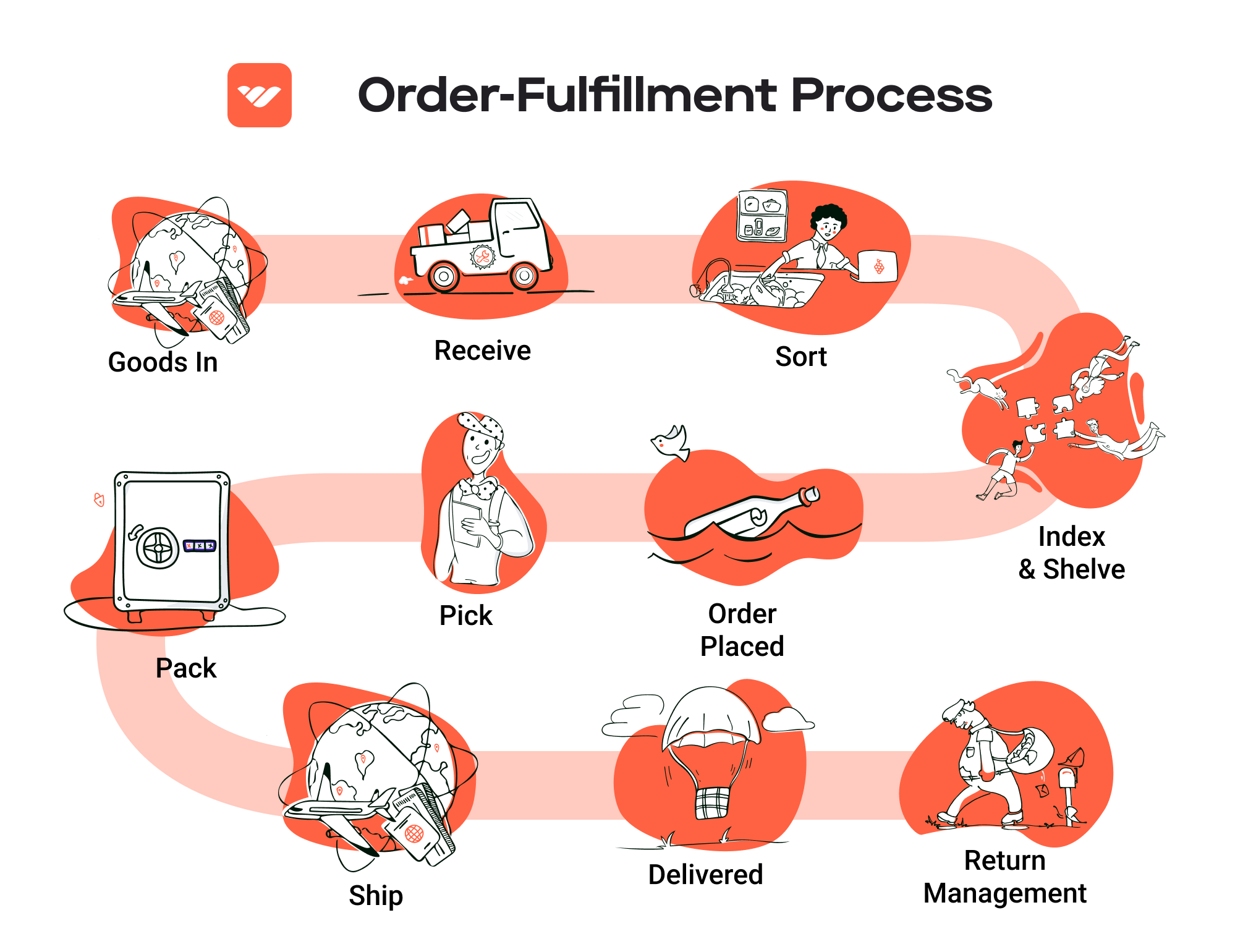
Pros of FBA
-
Prime Eligibility: One of the significant advantages of using FBA is that products become eligible for Amazon Prime. This increases visibility and sales, as Prime members often prefer to buy items with faster shipping options.
-
Customer Trust: Amazon is a trusted brand with a robust reputation for customer service. By using FBA, sellers can leverage this trust, leading to higher conversion rates and customer satisfaction.
-
Multi-Channel Fulfillment: FBA can fulfill orders from other sales channels, such as eBay, Shopify, or a seller’s own website. This flexibility allows businesses to consolidate their logistics processes and improve efficiency.
-
Scalability: As businesses grow, FBA allows for easy scalability. Sellers can increase their inventory without worrying about the logistics of storage and shipping, enabling them to focus on marketing and sales.
-
Time-Saving: By outsourcing fulfillment to Amazon, sellers save significant time and effort in managing inventory, packing, and shipping processes, allowing them to concentrate on other critical aspects of their business.
Cons of FBA
-
High Fees: FBA comes with various fees, including storage fees for keeping products in Amazon’s warehouses and fulfillment fees for picking, packing, and shipping. These fees can significantly eat into profit margins, particularly for low-cost items.
-
Strict Inventory Rules: Amazon has stringent inventory management policies that sellers must adhere to. Failing to comply can result in penalties, additional fees, or even the removal of listings.
-
Commingling Risks: When using FBA, sellers’ products may be stored alongside those of other sellers. This commingling can lead to potential issues, such as receiving returns for items that are not yours or shipping the wrong product to a customer, impacting brand reputation.
-
Limited Control Over Fulfillment: Sellers have limited control over how their products are stored and handled within Amazon’s warehouses. Any issues with packaging or shipping can reflect poorly on the seller, even if they are not directly responsible.
-
Inventory Management Challenges: Managing inventory levels can be challenging, as sellers must balance the need for sufficient stock to meet demand while avoiding excess inventory that incurs high storage fees.
Who is FBA Best For?
Fulfillment by Amazon is particularly well-suited for:
-
Small to Medium-Sized Businesses: Sellers who lack the infrastructure to handle logistics efficiently will benefit from FBA’s extensive resources and expertise.
-
E-commerce Entrepreneurs: New sellers looking to establish a presence on Amazon can leverage FBA to access Prime members and benefit from Amazon’s reputation.
-
Sellers with High-Volume Sales: Businesses that anticipate high sales volume can take advantage of the scalability that FBA provides, allowing them to grow without the burden of logistics.
-
Brands Seeking Increased Visibility: If a seller’s primary goal is to increase brand awareness and sales, FBA’s eligibility for Prime and Amazon’s customer trust can significantly enhance product visibility.
-
Multi-Channel Sellers: Businesses that sell on various platforms can benefit from FBA’s multi-channel fulfillment capabilities, streamlining their operations and simplifying inventory management.
In conclusion, while Fulfillment by Amazon offers numerous advantages, it is essential for potential users to weigh these benefits against the drawbacks. Understanding the implications of FBA on their business model will help sellers make informed decisions as they scale their e-commerce operations.
Core Services Offered by Fulfillment Centers
Inventory Management & Warehousing
Inventory management and warehousing are foundational services provided by fulfillment centers that significantly impact the efficiency of e-commerce operations. In essence, this service involves the systematic handling of stock, from the moment products arrive at the warehouse until they are picked for shipment. Fulfillment centers utilize sophisticated inventory management systems that track product quantities, locations, and turnover rates.
Benefits for E-commerce Businesses:
1. Real-Time Visibility: Businesses gain access to real-time data regarding inventory levels, which helps in making informed decisions about restocking and managing supply chains effectively.
2. Reduced Storage Costs: By leveraging the warehousing capabilities of fulfillment centers, businesses can avoid the overhead costs associated with maintaining their own storage facilities. This leads to better cash flow management.
3. Optimized Space Utilization: Fulfillment centers utilize advanced storage solutions, including vertical shelving and automated retrieval systems, which maximize space and minimize waste.
4. Scalability: As a business grows, fulfillment centers provide the flexibility to scale inventory without the need for significant investments in physical infrastructure.
Pick and Pack Services
Pick and pack services refer to the process of selecting products from inventory based on customer orders and preparing them for shipment. This service is crucial for maintaining order accuracy and speed, as it directly affects the customer experience. Fulfillment centers typically employ a combination of technology and human labor to optimize this process.
Benefits for E-commerce Businesses:
1. Increased Efficiency: Automation tools, such as robotic pickers and barcode scanning systems, streamline the picking process, reducing the time from order placement to shipment. This efficiency is vital for meeting customer expectations, especially for same-day or next-day deliveries.
2. Accuracy in Order Fulfillment: Systems in place at fulfillment centers ensure that the right products are picked and packed, minimizing errors that can lead to returns and dissatisfied customers.
3. Cost Savings: By outsourcing pick and pack services, businesses can reduce labor costs and focus on core activities, such as marketing and product development, rather than logistics.
4. Flexibility in Order Size: Fulfillment centers can handle orders of varying sizes, from single items to bulk shipments, accommodating the diverse needs of e-commerce businesses.
Kitting and Assembly
Kitting and assembly services involve the grouping of individual items into ready-to-ship sets or kits. This service is particularly beneficial for businesses that sell products that need to be bundled together or require assembly before shipping. Fulfillment centers can efficiently manage this process, ensuring that kits are assembled accurately and shipped promptly.
Benefits for E-commerce Businesses:
1. Value-Added Services: Kitting adds value by providing customers with ready-to-use products, which can enhance customer satisfaction and encourage repeat purchases.
2. Streamlined Operations: By outsourcing kitting and assembly, businesses can streamline their operations, reducing the complexity of inventory management and order fulfillment.
3. Cost Efficiency: Fulfillment centers can achieve economies of scale in kitting operations, leading to reduced costs per kit. This can be especially advantageous for seasonal promotions or product launches.
4. Improved Marketing Opportunities: Kitting allows businesses to create attractive product bundles that can be marketed as special offers, driving sales and increasing average order value.
Returns Management (Reverse Logistics)
Returns management, or reverse logistics, is a critical service offered by fulfillment centers that helps businesses efficiently handle product returns. This process involves receiving returned items, assessing their condition, restocking them if possible, or disposing of them appropriately.
Benefits for E-commerce Businesses:
1. Enhanced Customer Experience: A streamlined returns process can significantly improve customer satisfaction. Customers appreciate hassle-free returns, which can lead to higher retention rates and loyalty.
2. Cost Control: Effective returns management helps businesses minimize losses associated with returned products. Fulfillment centers can quickly process returns, assess the condition of the items, and determine the most cost-effective way to handle them.
3. Data Insights: Returns data can provide valuable insights into customer preferences and product performance. Businesses can analyze return reasons to improve product offerings and reduce future returns.
4. Sustainability Initiatives: Many fulfillment centers are equipped to handle returns sustainably, such as refurbishing items or recycling materials, aligning with eco-conscious business practices that appeal to modern consumers.
In summary, fulfillment centers offer a suite of core services that are essential for the efficient operation of e-commerce businesses. By leveraging inventory management, pick and pack services, kitting and assembly, and returns management, businesses can enhance operational efficiency, improve customer satisfaction, and ultimately scale their operations effectively.
How to Choose a Fulfillment Partner: A 6-Point Checklist
Location & Warehouse Network
Why It Matters:
The geographical location of your fulfillment partner’s warehouses can significantly affect shipping times and costs. A partner with strategically placed fulfillment centers can help ensure faster delivery to your customers, which is essential for maintaining a competitive edge in e-commerce.
Questions to Ask:
– Where are your fulfillment centers located, and how does that align with my customer base?
– Do you have multiple warehouses, and can you distribute inventory across them?
– What is your average shipping time to various regions, and how do you handle shipping costs?
Technology & Integrations
Why It Matters:
In today’s digital landscape, technology plays a crucial role in the efficiency of order fulfillment. A partner with robust technology can streamline processes, reduce errors, and provide real-time tracking for both you and your customers.
Questions to Ask:
– What technology platforms do you use for inventory management and order processing?
– Can your system integrate with my e-commerce platform (e.g., Shopify, Amazon)?
– Do you provide real-time tracking and reporting capabilities for inventory and orders?
Specializations (e.g., Cold Storage, Oversized Items)
Why It Matters:
Not all fulfillment partners are equipped to handle specialized products. If you sell items that require specific storage conditions (like perishables) or oversized products, it’s essential to partner with a 3PL that has the necessary facilities and experience.
Questions to Ask:
– Do you have specialized facilities for items like perishables or oversized goods?
– What protocols do you have in place for handling and storing these types of products?
– Can you provide examples of how you have successfully managed specialized inventory for other clients?
Scalability & Capacity
Why It Matters:
As your business grows, your fulfillment needs will likely change. A partner that can scale with you—whether it’s accommodating seasonal spikes or expanding your product lines—can save you time and resources.
Questions to Ask:
– How do you manage fluctuations in order volume, especially during peak seasons?
– What is your capacity for scaling operations if my business grows?
– Can you provide examples of how you have helped other clients scale their fulfillment operations?
Pricing and Contracts
Why It Matters:
Understanding the pricing structure and contract terms is critical to avoiding unexpected costs. Clear pricing will help you budget effectively and ensure that you’re getting value for your investment.
Questions to Ask:
– What is your pricing model (e.g., per order, per item, monthly fees)?
– Are there additional costs for services like returns, storage, or packaging?
– What are the terms of your contracts, and what is your policy on contract termination or changes?
Customer Support & Reviews
Why It Matters:
Strong customer support is crucial for resolving issues quickly and efficiently. Additionally, checking reviews can provide insights into the partner’s reliability and service quality.
Questions to Ask:
– What customer support options do you offer (e.g., phone, email, chat)?
– What is your average response time for customer inquiries?
– Can you provide references or testimonials from current or past clients?
Conclusion
Choosing the right fulfillment partner is a critical decision that can significantly impact your e-commerce business. By using this checklist, you can systematically evaluate potential partners to ensure they align with your operational needs and business goals. Taking the time to ask the right questions will help you make an informed choice that supports your growth and enhances your customer experience.
Understanding Fulfillment Pricing: A Breakdown of Common Fees
Initial Setup Fees
When partnering with a fulfillment center, the initial setup fees are often the first costs you encounter. These fees can cover a variety of services, including account setup, integration with your e-commerce platform, and any necessary training for your team. The setup process may involve configuring software systems, connecting your inventory management tools, and establishing protocols for order processing.
Typically, initial setup fees are calculated as a flat rate. However, the complexity of your business operations can influence this amount. For example, if you have a large catalog of products or require custom integrations, you may face higher fees. Businesses should budget for these costs early on to avoid surprises and ensure a smooth transition to the fulfillment center.
Receiving Fees
Receiving fees are charged for the process of accepting and inspecting inventory as it arrives at the fulfillment center. This includes unloading shipments, checking for damages, and logging products into the inventory system.
These fees are generally calculated on a per-unit basis, where you pay a specific amount for each item received. Some fulfillment centers may also charge based on the weight or volume of the shipment. It’s important to clarify these details with your provider, as they can significantly impact your overall fulfillment costs, especially if you frequently send large shipments.
Storage Fees (per pallet/bin)
Storage fees are ongoing costs incurred for keeping your inventory in the fulfillment center. These fees can be charged monthly and are often calculated based on the space your products occupy—typically measured in pallets or bins.
For example, a fulfillment center might charge a monthly fee per pallet, which could range from $10 to $30, depending on the facility’s location and size. Additionally, some centers may implement tiered pricing, where the cost per pallet decreases as you store more inventory. This can incentivize businesses to hold larger quantities, but it’s crucial to balance storage costs with inventory turnover rates to avoid overstocking.
Pick & Pack Fees (per item/order)
Pick and pack fees are associated with the labor involved in retrieving items from storage, packing them for shipment, and preparing them for delivery. This is a critical component of the fulfillment process, as it directly affects order accuracy and customer satisfaction.
Fulfillment centers typically charge a fee for each item picked and packed. For instance, you might see a charge of $1 to $3 per item, depending on the complexity of the packing process. Some centers may also offer flat-rate pricing per order, which can be beneficial if you ship multiple items in a single order. It’s essential to understand how your fulfillment center structures these fees, as they can vary significantly based on the nature of your products (e.g., bulky items may incur higher fees).
Shipping Fees
Shipping fees cover the cost of transporting packages from the fulfillment center to the customer. These fees can vary widely based on several factors, including package weight, dimensions, destination, and the shipping method selected (e.g., standard, expedited, or same-day delivery).
Most fulfillment centers use a tiered pricing model for shipping fees, where the cost per package decreases as the shipping volume increases. Additionally, some providers may negotiate rates with carriers, which can benefit businesses that ship large volumes. When calculating shipping fees, always consider the balance between speed and cost, as faster shipping options typically incur higher charges.
Tips for Getting an Accurate Quote
To obtain an accurate quote for fulfillment services, consider the following tips:
-
Provide Detailed Information: Be clear about your product types, order volumes, and specific fulfillment needs. The more information you provide, the better the fulfillment center can assess your requirements.
-
Ask About Fee Structures: Inquire how each fee is calculated—whether it’s per item, per pallet, or based on weight. Understanding the pricing model helps you anticipate costs.
-
Evaluate Additional Services: If you require special services such as kitting, labeling, or returns management, ask about the associated fees for these services upfront.
-
Negotiate Terms: Don’t hesitate to negotiate terms and rates, especially if you expect high volumes or long-term collaboration. Many fulfillment centers are open to adjusting their pricing models based on the potential for a lasting partnership.
-
Request a Breakdown: Ask for a detailed breakdown of all potential fees in your quote. This transparency helps you make informed decisions and budget effectively.
By taking these steps, you can ensure that you receive a comprehensive and accurate quote that aligns with your e-commerce business needs.
Frequently Asked Questions (FAQs) about Fulfillment
1. What is the Amazon Fulfillment Center EWR8?
The Amazon Fulfillment Center EWR8 is a large-scale warehouse located in Teterboro, NJ, designed to store, pack, and ship a wide variety of products for Amazon. It plays a crucial role in the logistics chain, ensuring efficient and timely delivery of customer orders across the region.
2. What services does EWR8 provide for e-commerce sellers?
EWR8 offers Fulfillment by Amazon (FBA) services, which allow e-commerce sellers to send their inventory to the fulfillment center. Amazon then handles the entire order fulfillment process, including storage, picking, packing, and shipping, enabling sellers to focus on growing their businesses.
3. How does the fulfillment process work at EWR8?
The fulfillment process at EWR8 involves several key steps:
– Receiving Inventory: Products are received and sorted upon arrival.
– Stowing: Inventory is organized and stored efficiently within the warehouse.
– Order Processing: When a customer places an order, the system processes it automatically.
– Picking and Packing: Items are picked from storage, packed securely, and prepared for shipping.
– Shipping: Orders are shipped out using various carriers, ensuring quick delivery to customers.
4. What is the difference between a warehouse and a fulfillment center?
A warehouse primarily focuses on storing goods and may not have the infrastructure for order processing, packing, and shipping. In contrast, a fulfillment center, like EWR8, specializes in the entire order fulfillment process, providing services such as inventory management, order picking, packing, and direct shipping to customers.
5. What is a third-party logistics provider (3PL)?
A third-party logistics provider (3PL) is a company that offers outsourced logistics services to businesses. This includes warehousing, transportation, and fulfillment services. Utilizing a 3PL like Amazon’s fulfillment centers allows e-commerce businesses to scale operations efficiently without the burden of managing logistics in-house.
6. How much do fulfillment services cost at EWR8?
Costs for fulfillment services at EWR8 can vary based on several factors, including the volume of inventory, the nature of the products, and the specific services utilized (such as storage, picking, packing, and shipping). It is advisable to contact Amazon directly or consult their pricing guidelines for detailed information tailored to your business needs.
7. How can I track my inventory in the EWR8 fulfillment center?
Inventory tracking at EWR8 is managed through Amazon’s sophisticated inventory management system. Sellers can monitor their stock levels, order status, and fulfillment metrics through the Seller Central dashboard, allowing for real-time visibility and effective inventory management.
8. What kind of products can be stored at EWR8?
EWR8 can accommodate a wide range of products, from electronics to clothing and household goods. However, certain restrictions apply to hazardous materials or items that do not comply with Amazon’s fulfillment policies. It is essential to review the guidelines provided by Amazon to ensure your products are eligible for storage.
9. How long does it take for orders to be processed and shipped from EWR8?
Order processing and shipping times at EWR8 can vary based on factors such as order volume, shipping method selected by the customer, and time of day the order is placed. Typically, Amazon strives for quick processing, often shipping Prime orders within one to two days.
10. What are the benefits of using Amazon Fulfillment Center EWR8 for my business?
Using EWR8 can provide several advantages, including:
– Scalability: Easily adjust to changes in order volume without investing in additional warehousing.
– Speed: Leverage Amazon’s logistics network for fast shipping options.
– Cost Efficiency: Reduce overhead costs associated with managing your own fulfillment operations.
– Access to Amazon Prime: Enable your products to be eligible for Amazon Prime, attracting more customers.
– Enhanced Customer Service: Benefit from Amazon’s established customer service and return processing systems.
Conclusion: Is Outsourcing Fulfillment the Right Move for Your Business?
Evaluating the Benefits of Outsourcing Fulfillment
Outsourcing fulfillment can be a transformative decision for e-commerce businesses looking to scale efficiently and effectively. By partnering with a fulfillment center like Amazon Fulfillment Center-Ewr8, businesses can unlock several key advantages that contribute to growth and operational excellence.
First and foremost, outsourcing fulfillment saves time. Managing logistics, inventory, and shipping in-house can consume valuable resources that could otherwise be directed toward strategic initiatives, such as marketing and product development. By entrusting these tasks to a specialized fulfillment partner, businesses can focus on their core competencies while ensuring orders are processed and delivered swiftly.
Scalability is another significant benefit. As your business grows, so do the demands of order fulfillment. A robust fulfillment partner provides the infrastructure and resources necessary to accommodate fluctuations in order volume without the need for substantial capital investment. This flexibility allows businesses to respond to market demands quickly, whether during peak seasons or unexpected surges in sales.
Moreover, fulfillment centers bring expertise to the table. With advanced technologies, streamlined processes, and industry best practices, these partners can enhance accuracy and efficiency in order processing. This not only improves customer satisfaction through timely deliveries but also minimizes errors that can lead to costly returns or lost sales.
However, the success of outsourcing fulfillment hinges on selecting the right partner. It’s crucial to assess potential fulfillment providers based on their capabilities, reliability, and alignment with your business goals.
Take Action
To determine if outsourcing fulfillment is the right move for your business, conduct a thorough audit of your current shipping processes. Evaluate your operational pain points, costs, and customer satisfaction levels. This exercise can illuminate whether partnering with a fulfillment service will provide the strategic advantage needed to propel your business forward. Embrace the opportunity to scale with confidence and efficiency.
Important Disclaimer
⚠️ Important Disclaimer
The information in this guide is for educational purposes. Fulfillment services, pricing, and platform features change frequently. Always conduct your own due diligence and consult with providers directly before making business decisions.
